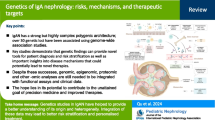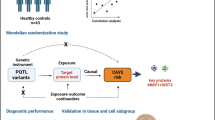Abstract
Aim
The study is aimed to detect the expression of serum Sirtuin 6 (SIRT6) with different severities and urinary albumin creatinine ratios (UACR) in type 2 diabetes mellitus (T2DM) patients, thus exploring the association of SIRT6 together with glycolipid metabolism and urinary protein in the cross-sectional study.
Methods
T2DM patients (313 cases), pre-diabetic patients (102 cases), and healthy volunteers (100 cases) were selected. T2DM patients were divided into the normal albuminuria (103 cases, UACR < 30 mg/g), micro-albuminuria (106 cases, UACR 30–300 mg/g), and large amount of albuminuria group (104 cases, UACR > 300 mg/g) based on different UACR levels. The medical history was asked, biochemical indicators were detected, hematuria samples were taken, serum SIRT6 levels were detected, and detailed statistical analysis was conducted.
Results
FPG, 2 h-PG, HOMA-IR, HbA1c, and LDL-C increased, while ISI and HDL-C decreased with the aggravation of diabetic status (P < 0.05). HbA1c, UACR, TNFα, HIF1α, and SIRT6 increased with UACR in T2DM patients (P < 0.05). Correlation analysis demonstrated that SIRT6 was significantly positively correlated with glycolipid metabolism in the whole samples, and correlated with UACR, TNFα, and HIF1α in T2DM patients (P < 0.05). Ridge regression analysis showed that SIRT6 was a risk factor for both glycolipid metabolism and urinary protein (P < 0.05).
Conclusion
SIRT6 increases with biomarkers in glycolipid metabolism and urinary protein in different severities of diabetes and UACR, which is expected to be a potential biomarker for early prediction and diagnosis related to glycolipid metabolism disorders and related nephropathy.
Trial number: ChiCTR2000039808.




Similar content being viewed by others
References
Classification and Diagnosis of Diabetes (2018) Standards of medical care in diabetes-2018. Diabetes Care 41:S13-s27
Stevens PE, Levin A (2013) Evaluation and management of chronic kidney disease: synopsis of the kidney disease: improving global outcomes 2012 clinical practice guideline. Ann Intern Med 158:825–830
Tasselli L, Zheng W, Chua KF (2017) SIRT6: novel mechanisms and links to aging and disease. Trends Endocrinol Metab 28:168–185
Frye RA (2000) Phylogenetic classification of prokaryotic and eukaryotic sir2-like proteins. Biochem Biophys Res Commun 273:793–798
Liu TF, Vachharajani VT, Yoza BK, McCall CE (2012) NAD+-dependent sirtuin 1 and 6 proteins coordinate a switch from glucose to fatty acid oxidation during the acute inflammatory response. J Biol Chem 287:25758–25769
Elhanati S, Kanfi Y, Varvak A, Roichman A, Carmel-Gross I, Barth S et al (2013) Multiple regulatory layers of SREBP1/2 by SIRT6. Cell Rep 4:905–912
Kugel S, Mostoslavsky R (2014) Chromatin and beyond: the multitasking roles for SIRT6. Trends Biochem Sci 39:72–81
Vitiello M, Zullo A, Servillo L, Mancini FP, Borriello A, Giovane A et al (2017) Multiple pathways of SIRT6 at the crossroads in the control of longevity, cancer, and cardiovascular diseases. Ageing Res Rev 35:301–311
Ji L, Chen Y, Wang H, Zhang W, He L, Wu J et al (2019) Overexpression of Sirt6 promotes M2 macrophage transformation, alleviating renal injury in diabetic nephropathy. Int J Oncol 55:103–115
Liu M, Liang K, Zhen J, Zhou M, Wang X, Wang Z et al (2017) Sirt6 deficiency exacerbates podocyte injury and proteinuria through targeting notch signaling. Nat Commun 8:413
Zhang Y, Wang L, Meng L, Cao G, Wu Y (2019) Sirtuin 6 overexpression relieves sepsis-induced acute kidney injury by promoting autophagy. Cell Cycle 18:425–436
Jiang C, Sun ZM, Hu JN, Jin Y, Guo Q, Xu JJ et al (2019) Cyanidin ameliorates the progression of osteoarthritis via the Sirt6/NF-κB axis in vitro and in vivo. Food Funct 10:5873–5885
Zhong L, D’Urso A, Toiber D, Sebastian C, Henry RE, Vadysirisack DD et al (2010) The histone deacetylase Sirt6 regulates glucose homeostasis via Hif1alpha. Cell 140:280–293
Schorr GS, Falcone EA, Moretti DJ, Andrews RD (2014) First long-term behavioral records from cuvier’s beaked whales (Ziphius cavirostris) reveal record-breaking dives. PLoS One. 9:e92633
Rosolowsky ET, Skupien J, Smiles AM, Niewczas M, Roshan B, Stanton R et al (2011) Risk for ESRD in type 1 diabetes remains high despite renoprotection. J Am Soc Nephrol 22:545–553
Nelson RG, Newman JM, Knowler WC, Sievers ML, Kunzelman CL, Pettitt DJ et al (1988) Incidence of end-stage renal disease in type 2 (non-insulin-dependent) diabetes mellitus in Pima Indians. Diabetologia 31:730–736
Alicic RZ, Rooney MT, Tuttle KR (2017) Diabetic kidney disease: challenges, progress, and possibilities. Clin J Am Soc Nephrol: CJASN 12:2032–2045
D’Addio F, Trevisani A, Ben Nasr M et al (2014) Harnessing the immunological properties of stem cells as a therapeutic option for diabetic nephropathy. Acta Diabetol 51(6):897–904. https://doi.org/10.1007/s00592-014-0603-1
Niewczas MA, Pavkov ME, Skupien J et al (2019) A signature of circulating inflammatory proteins and development of end-stage renal disease in diabetes. Nat Med 25(5):805–813. https://doi.org/10.1038/s41591-019-0415-5
Yao L, Cui X, Chen Q, Yang X, Fang F, Zhang J et al (2017) Cold-inducible SIRT6 regulates thermogenesis of brown and beige fat. Cell Rep 20:641–654
Xiong X, Zhang C, Zhang Y, Fan R, Qian X, Dong XC (2017) Fabp4-Cre-mediated Sirt6 deletion impairs adipose tissue function and metabolic homeostasis in mice. J Endocrinol 233:307–314
Kuang J, Zhang Y, Liu Q, Shen J, Pu S, Cheng S et al (2017) Fat-specific Sirt6 ablation sensitizes mice to high-fat diet-induced obesity and insulin resistance by inhibiting lipolysis. Diabetes 66:1159–1171
Kanfi Y, Peshti V, Gil R, Naiman S, Nahum L, Levin E et al (2010) SIRT6 protects against pathological damage caused by diet-induced obesity. Aging Cell 9:162–173
Kim HS, Xiao C, Wang RH, Lahusen T, Xu X, Vassilopoulos A et al (2010) Hepatic-specific disruption of SIRT6 in mice results in fatty liver formation due to enhanced glycolysis and triglyceride synthesis. Cell Metab 12:224–236
Fiorina P, Vergani A, Bassi R et al (2014) Role of podocyte B7–1 in diabetic nephropathy. J Am Soc Nephrol 25(7):1415–1429. https://doi.org/10.1681/ASN.2013050518
Zelová H, Hošek J (2013) TNF-α signalling and inflammation: interactions between old acquaintances. Inflamm Res: Off J Eur Histamine Res Soc[et al] 62:641–651
Jiang H, Khan S, Wang Y, Charron G, He B, Sebastian C et al (2013) SIRT6 regulates TNF-α secretion through hydrolysis of long-chain fatty acyl lysine. Nature 496:110–113
Lappas M (2012) Anti-inflammatory properties of sirtuin 6 in human umbilical vein endothelial cells. Med Inflamma 2012:597514
Van Gool F, Gallí M, Gueydan C, Kruys V, Prevot PP, Bedalov A et al (2009) Intracellular NAD levels regulate tumor necrosis factor protein synthesis in a sirtuin-dependent manner. Nat Med 15:206–210
He Y, Xiao Y, Yang X, Li Y, Wang B, Yao F et al (2017) SIRT6 inhibits TNF-α-induced inflammation of vascular adventitial fibroblasts through ROS and Akt signaling pathway. Exp Cell Res 357:88–97
Xiao C, Wang RH, Lahusen TJ, Park O, Bertola A, Maruyama T et al (2012) Progression of chronic liver inflammation and fibrosis driven by activation of c-JUN signaling in Sirt6 mutant mice. J Biol Chem 287:41903–41913
Li HS, Zhou YN, Li L, Li SF, Long D, Chen XL et al (2019) HIF-1α protects against oxidative stress by directly targeting mitochondria. Redox Biol 25:101109
Hu CJ, Iyer S, Sataur A, Covello KL, Chodosh LA, Simon MC (2006) Differential regulation of the transcriptional activities of hypoxia-inducible factor 1 alpha (HIF-1alpha) and HIF-2alpha in stem cells. Mol Cell Biol 26:3514–3526
Acknowledgements
Our team would like to thank the Clinical and Central Laboratory of the Fourth Affiliated Hospital of China Medical University, Laboratory of Nuclear Receptor and Major Metabolic Disease, and the Kidney Disease Center of Dalian Medical University for technical assistance and equipment support. This study was supported by the Doctoral Research Initiation Fund Project of Liaoning Province applied by HR.
Author information
Authors and Affiliations
Contributions
CB was involved in conceptualization, methodology, software, validation, formal analysis, investigation, resources, data curation, writing-original draft, visualization, project administration, and funding acquisition. JG helped in methodology, validation, formal analysis, resources, data curation, and writing—review & editing. YW, JL, ZL, and HL contributed to formal analysis, resources, and data curation. HR was involved in conceptualization, methodology, software, validation, formal analysis, investigation, data curation, writing-original draft, writing—review & editing, visualization, supervision, and funding acquisition. Details of the author's contribution are listed in Supplemental Table 1.
Corresponding author
Ethics declarations
Conflict of interest
The authors declare that they have no conflicts of interest.
Human and animal rights
All human studies have been reviewed and approved by the Medical Ethics Committee of the Fourth Affiliated Hospital of China Medical University (Approval Number: EC-2020-KS-036) and have therefore been performed in accordance with the ethical standards laid down in an appropriate version of the 1964 Declaration of Helsinki. All persons gave their informed consent prior to their inclusion in the study, and details that might disclose the identity of the subjects under study were omitted.
Additional information
Managed by Massimo Federici.
Publisher's Note
Springer Nature remains neutral with regard to jurisdictional claims in published maps and institutional affiliations.
Supplementary Information
Below is the link to the electronic supplementary material.
Rights and permissions
About this article
Cite this article
Bian, C., Gao, J., Wang, Y. et al. Association of SIRT6 circulating levels with urinary and glycometabolic markers in pre-diabetes and diabetes. Acta Diabetol 58, 1551–1562 (2021). https://doi.org/10.1007/s00592-021-01759-x
Received:
Accepted:
Published:
Issue Date:
DOI: https://doi.org/10.1007/s00592-021-01759-x




